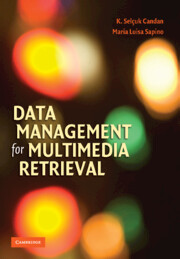Book contents
- Frontmatter
- Contents
- Preface
- 1 Introduction: Multimedia Applications and Data Management Requirements
- 2 Models for Multimedia Data
- 3 Common Representations of Multimedia Features
- 4 Feature Quality and Independence: Why and How?
- 5 Indexing, Search, and Retrieval of Sequences
- 6 Indexing, Search, and Retrieval of Graphs and Trees
- 7 Indexing, Search, and Retrieval of Vectors
- 8 Clustering Techniques
- 9 Classification
- 10 Ranked Retrieval
- 11 Evaluation of Retrieval
- 12 User Relevance Feedback and Collaborative Filtering
- Bibliography
- Index
- Plate section
2 - Models for Multimedia Data
Published online by Cambridge University Press: 05 July 2014
- Frontmatter
- Contents
- Preface
- 1 Introduction: Multimedia Applications and Data Management Requirements
- 2 Models for Multimedia Data
- 3 Common Representations of Multimedia Features
- 4 Feature Quality and Independence: Why and How?
- 5 Indexing, Search, and Retrieval of Sequences
- 6 Indexing, Search, and Retrieval of Graphs and Trees
- 7 Indexing, Search, and Retrieval of Vectors
- 8 Clustering Techniques
- 9 Classification
- 10 Ranked Retrieval
- 11 Evaluation of Retrieval
- 12 User Relevance Feedback and Collaborative Filtering
- Bibliography
- Index
- Plate section
Summary
A database is a collection of data objects that are organized in a way that supports effective search and manipulation. Under this definition, your personal collection of digital photos can be considered a database (more specifically an image database) if you feel that the software you are using to organize your images provides you with mechanisms that help you locate the images you are looking for easily and effectively.
Effective access, of course, depends on the data and the application. For example, in general, you may be satisfied if the images in your collection are organized in terms of a timeline or put into folders according to where they were taken, but for an advertising agency which is looking for an image that conveys a certain feeling or for a medical research center which is trying to locate images that contain a particular pattern, such a metadata-based organization (i.e., an organization not based on the content of the image, but on aspects of the media object external to the visual content) may not be acceptable. Thus, when creating a database, it is important to choose the right organization model.
A data model is a formalism that helps specify the aspects of the data relevant for their organization. For example, a content-based model would describe what type of content (e.g., colors or shape) is relevant for the organization of the data in the database, whereas a metadata-based model may help specify the metadata (e.g., date or place) relevant for the organization.
- Type
- Chapter
- Information
- Data Management for Multimedia Retrieval , pp. 20 - 98Publisher: Cambridge University PressPrint publication year: 2010

